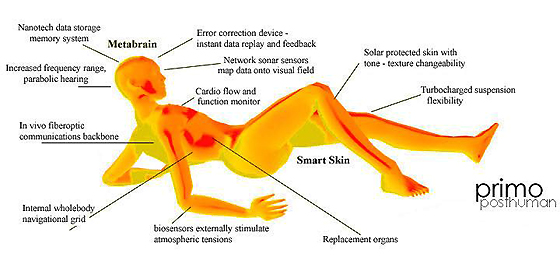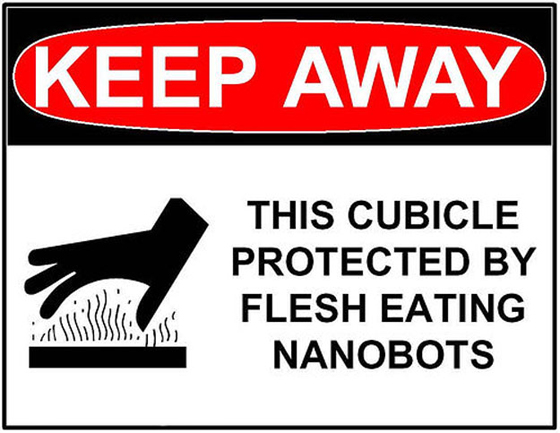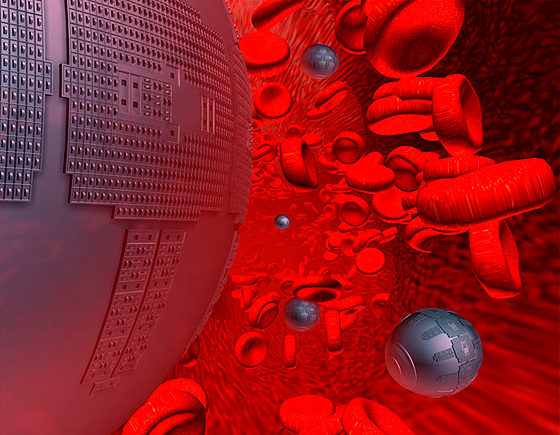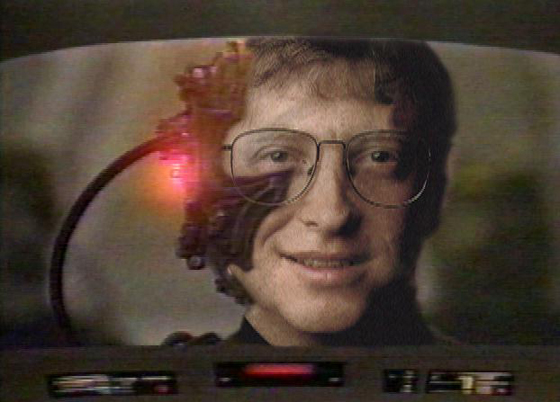Human Body Version 2.0
by Lifeboat Foundation Scientific Advisory Board member Ray Kurzweil.In the coming decades, a radical upgrading of our body’s physical and mental systems, already underway, will use nanobots to augment and ultimately replace our organs. We already know how to prevent most degenerative disease through nutrition and supplementation; this will be a bridge to the emerging biotechnology revolution, which in turn will be a bridge to the nanotechnology revolution. By 2030, reverse-engineering of the human brain will have been completed and nonbiological intelligence will merge with our biological brains.
Overview
Sex has already been largely separated from its biological function. For the most part, we engage in sexual activity for intimate communication and sensual pleasure, not reproduction. Conversely, we have multiple methodologies for creating babies without physical sex, albeit most reproduction still does derive from the sex act. Although not condoned by all sectors of society, this disentanglement of sex from its biological function has been readily, even eagerly, adopted by the mainstream.So why don’t we provide the same extrication of purpose from biology for another activity that also provides both social intimacy and sensual pleasure, namely eating? We have crude ways of doing this today. Starch blockers, such as Bayer’s Precose, partially prevent absorption of complex carbohydrates; fat blockers, such as Chitosan, bind to fat molecules, causing them to pass through the digestive tract; and sugar substitutes, such as Sucralose and Stevia, provide sweetness without calories. There are limitations and problems with each of these contemporary technologies, but a more effective generation of drugs is being developed that will block excess caloric absorption on the cellular level.
Let us consider, however, a more fundamental reengineering of the digestive process to disconnect the sensual aspects of eating from its original biological purpose: to provide nutrients into the bloodstream that are then delivered to each of our trillions of cells. These nutrients include caloric (energy-bearing) substances such as glucose (from carbohydrates), proteins, fats, and a myriad of trace molecules, such as vitamins, minerals, and phytochemicals, that provide building blocks and facilitating enzymes for diverse metabolic processes.
An Era of Abundance

Our knowledge of the complex pathways underlying digestive processes is rapidly expanding, although there is still a great deal we do not fully understand. On the one hand, digestion, like any other major human biological system, is astonishing in its intricacy and cleverness. Our bodies manage to extract the complex resources needed to survive, despite sharply varying conditions, while at the same time, filtering out a multiplicity of toxins.
On the other hand, our bodies evolved in a very different era. Our digestive processes in particular are optimized for a situation that is dramatically dissimilar to the one we find ourselves in. For most of our biological heritage, there was a high likelihood that the next foraging or hunting season (and for a brief, relatively recent period, the next planting season) might be catastrophically lean. So it made sense for our bodies to hold on to every possible calorie. Today, this biological strategy is extremely counterproductive. Our outdated metabolic programming underlies our contemporary epidemic of obesity and fuels pathological processes of degenerative disease such as coronary artery disease, and type II diabetes.
Up until recently (on an evolutionary time scale), it was not in the interest of the species for old people like myself (I was born in 1948) to use up the limited resources of the clan. Evolution favored a short life span — life expectancy was 37 years only two centuries ago—so these restricted reserves could be devoted to the young, those caring for them, and those strong enough to perform intense physical work.
We now live in an era of great material abundance. Most work requires mental effort rather than physical exertion. A century ago, 30 percent of the U.S. work force worked on farms, with another 30 percent deployed in factories. Both of these figures are now under 3 percent. The significant majority of today’s job categories, ranging from airline flight attendant to web designer, simply didn’t exist a century ago. Circa 2003, we have the opportunity to continue to contribute to our civilization’s exponentially growing knowledge base — incidentally, a unique attribute of our species—well past our child-rearing days.
Our species has already augmented the “natural” order of our life cycle through our technology: drugs, supplements, replacement parts for virtually all bodily systems, and many other interventions. We already have devices to replace our hips, knees, shoulders, elbows, wrists, jaws, teeth, skin, arteries, veins, heart valves, arms, legs, feet, fingers, and toes. Systems to replace more complex organs (for example, our hearts) are beginning to work. As we’re learning the principles of operation of the human body and the brain, we will soon be in a position to design vastly superior systems that will be more enjoyable, last longer, and perform better, without susceptibility to breakdown, disease, and aging.
Artist and cultural catalyst Natasha Vita-More pioneered a conceptual design for one such system, called Primo Posthuman, designed for mobility, flexibility and superlongevity. It features innovations such as a metabrain for global-net connection with prosthetic neo-neocortex of AI interwoven with nanobots; smart skin that is solar protected with biosensors for tone and texture changeability, and high-acuity senses.
Introducing Human Body Version 2.0

We won’t engineer human body version 2.0 all at once. It will be an incremental process, one already well under way. Although version 2.0 is a grand project, ultimately resulting in the radical upgrading of all our physical and mental systems, we will implement it one benign step at a time. Based on our current knowledge, we can already touch and feel the means for accomplishing each aspect of this vision.
From this perspective, let’s return to a consideration of the digestive system. We already have a reasonably comprehensive picture of the constituent ingredients of the food we eat. We already have the means to survive without eating, using intravenous nutrition (for people who are unable to eat), although this is clearly not a pleasant process, given the current limitations in our technologies for getting substances in and out of the blood stream.
The next phase of improvement will be largely biochemical, in the form of drugs and supplements that will block excess caloric absorption and otherwise reprogram metabolic pathways for optimal health. We already have the knowledge to prevent most instances of degenerative disease, such as heart disease, stroke, type II diabetes, and cancer, through comprehensive programs of nutrition and supplementation, something which I personally do, as described in my book Fantastic Voyage : Live Long Enough to Live Forever, coauthored with Terry Grossman, M.D. I view our current knowledge as a bridge to the full flowering of the biotechnology revolution, which in turn will be a bridge to the nanotechnology revolution.
It’s All About Nanobots

In a famous scene from the movie, The Graduate, Benjamin’s mentor gives him career advice in a single word: “plastics”. Today, that word might be “software”, or “biotechnology”, but in another couple of decades, the word is likely to be “nanobots”. Nanobots — blood-cell-sized robots — will provide the means to radically redesign our digestive systems, and, incidentally, just about everything else.
In an intermediate phase, nanobots in the digestive tract and bloodstream will intelligently extract the precise nutrients we need, call for needed additional nutrients and supplements through our personal wireless local area network, and send the rest of the food we eat on its way to be passed through for elimination.
If this seems futuristic, keep in mind that intelligent machines are already making their way into our blood stream. There are dozens of projects underway to create blood-stream-based “biological microelectromechanical systems” (bioMEMS) with a wide range of diagnostic and therapeutic applications. BioMEMS devices are being designed to intelligently scout out pathogens and deliver medications in very precise ways.
For example, a researcher at the University of Illinois at Chicago has created a tiny capsule with pores measuring only seven nanometers. The pores let insulin out in a controlled manner but prevent antibodies from invading the pancreatic Islet cells inside the capsule. These nanoengineered devices have cured rats with type I diabetes, and there is no reason that the same methodology would fail to work in humans. Similar systems could precisely deliver dopamine to the brain for Parkinson’s patients, provide blood-clotting factors for patients with hemophilia, and deliver cancer drugs directly to tumor sites. A new design provides up to 20 substance-containing reservoirs that can release their cargo at programmed times and locations in the body.
Kensall Wise, a professor of electrical engineering at the University of Michigan, has developed a tiny neural probe that can provide precise monitoring of the electrical activity of patients with neural diseases. Future designs are expected to also deliver drugs to precise locations in the brain. Kazushi Ishiyama at Tohoku University in Japan has developed micromachines that use microscopic-sized spinning screws to deliver drugs to small cancer tumors.
A particularly innovative micromachine developed by Sandia National Labs has actual microteeth with a jaw that opens and closes to trap individual cells and then implant them with substances such as DNA, proteins or drugs. There are already at least four major scientific conferences on bioMEMS and other approaches to developing micro- and nano-scale machines to go into the body and bloodstream.
Ultimately, the individualized nutrients needed for each person will be fully understood (including all the hundreds of phytochemicals) and easily and inexpensively available, so we won’t need to bother with extracting nutrients from food at all. Just as we routinely engage in sex today for its relational and sensual gratification, we will gain the opportunity to disconnect the eating of food from the function of delivering nutrients into the bloodstream.
This technology should be reasonably mature by the 2020s. Nutrients will be introduced directly into the bloodstream by special metabolic nanobots. Sensors in our bloodstream and body, using wireless communication, will provide dynamic information on the nutrients needed at each point in time.
A key question in designing this technology will be the means by which these nanobots make their way in and out of the body. As I mentioned above, the technologies we have today, such as intravenous catheters, leave much to be desired. A significant benefit of nanobot technology is that unlike mere drugs and nutritional supplements, nanobots have a measure of intelligence. They can keep track of their own inventories, and intelligently slip in and out of our bodies in clever ways. One scenario is that we would wear a special “nutrient garment” such as a belt or undershirt. This garment would be loaded with nutrient bearing nanobots, which would make their way in and out of our bodies through the skin or other body cavities.
At this stage of technological development, we will be able to eat whatever we want, whatever gives us pleasure and gastronomic fulfillment, and thereby unreservedly explore the culinary arts for their tastes, textures, and aromas. At the same time, we will provide an optimal flow of nutrients to our bloodstream, using a completely separate process. One possibility would be that all the food we eat would pass through a digestive tract that is now disconnected from any possible absorption into the bloodstream.
This would place a burden on our colon and bowel functions, so a more refined approach will dispense with the function of elimination. We will be able to accomplish this using special elimination nanobots that act like tiny garbage compactors. As the nutrient nanobots make their way from the nutrient garment into our bodies, the elimination nanobots will go the other way. Periodically, we would replace the nutrition garment for a fresh one. One might comment that we do obtain some pleasure from the elimination function, but I suspect that most people would be happy to do without it.
Ultimately we won’t need to bother with special garments or explicit nutritional resources. Just as computation will eventually be ubiquitous and available everywhere, so too will basic metabolic nanobot resources be embedded everywhere in our environment. In addition, an important aspect of this system will be maintaining ample reserves of all needed resources inside the body. Our version 1.0 bodies do this to only a very limited extent, for example, storing a few minutes of oxygen in our blood, and a few days of caloric energy in glycogen and other reserves. Version 2.0 will provide substantially greater reserves, enabling us to be separated from metabolic resources for greatly extended periods of time.
Once perfected, we will no longer need version 1.0 of our digestive system at all. I pointed out above that our adoption of these technologies will be cautious and incremental, so we will not dispense with the old-fashioned digestive process when these technologies are first introduced. Most of us will wait for digestive system version 2.1 or even 2.2 before being willing to do dispense with version 1.0. After all, people didn’t throw away their typewriters when the first generation of word processors was introduced. People held onto their vinyl record collections for many years after CDs came out (I still have mine). People are still holding onto their film cameras, although the tide is rapidly turning in favor of digital cameras.
However, these new technologies do ultimately dominate, and few people today still own a typewriter. The same phenomenon will happen with our reengineered bodies. Once we’ve worked out the inevitable complications that will arise with a radically reengineered gastrointestinal system, we will begin to rely on it more and more.
Programmable Blood

As we reverse-engineer (learn the principles of operation of) our various bodily systems, we will be in a position to engineer new systems that provide dramatic improvements. One pervasive system that has already been the subject of a comprehensive conceptual redesign is our blood.
One of the leading proponents of “nanomedicine”, (redesigning our biological systems through engineering on a molecular scale) and author of a book with the same name is Robert Freitas, Research Scientist at nanotechnology firm Zyvex Corp. Freitas’ ambitious manuscript is a comprehensive road map to rearchitecting our biological heritage. One of Freitas’ designs is to replace (or augment) our red blood cells with artificial “respirocytes” that would enable us to hold our breath for four hours or do a top-speed sprint for 15 minutes without taking a breath. Like most of our biological systems, our red blood cells perform their oxygenating function very inefficiently, and Freitas has redesigned them for optimal performance. He has worked out many of the physical and chemical requirements in impressive detail.
It will be interesting to see how this development is dealt with in athletic contests. Presumably, the use of respirocytes and similar systems will be prohibited from Olympic contests, but then we will have the specter of teenagers in junior high school gymnasiums routinely outperforming Olympic athletes.
Freitas envisions micron-size artificial platelets that could achieve hemostasis (bleeding control) up to 1,000 times faster than biological platelets. Freitas describes nanorobotic microbivores (white blood cell replacements) that will download software to destroy specific infections hundreds of times faster than antibiotics, and that will be effective against all bacterial, viral and fungal infections, with no limitations of drug resistance.
I’ve personally watched (through a microscope) my own white blood cells surround and devour a pathogen, and I was struck with the remarkable sluggishness of this natural process. Although replacing our blood with billions of nanorobotic devices will require a lengthy process of development, refinement, and regulatory approval, we already have the conceptual knowledge to engineer substantial improvements over the remarkable but very inefficient methods used in our biological bodies.
Have a Heart, or Not

The next organ on my hit list is the heart. It’s a remarkable machine, but it has a number of severe problems. It is subject to a myriad of failure modes, and represents a fundamental weakness in our potential longevity. The heart usually breaks down long before the rest of the body, and often very prematurely.
Although artificial hearts are beginning to work, a more effective approach will be to get rid of the heart altogether. Among Freitas’ designs are nanorobotic blood cell replacements that provide their own mobility. If the blood system moves with its own movement, the engineering issues of the extreme pressures required for centralized pumping can be eliminated. As we perfect the means of transferring nanobots to and from the blood supply, we can also continuously replace the nanobots comprising our blood supply.
Energy will be provided by microscopic-sized hydrogen fuel cells. Integrated Fuel Cell Technologies, one of many companies pioneering fuel cell technology, has already created microscopic-sized fuel cells. Their first-generation design provides tens of thousands of fuel cells on an integrated circuit and is intended to power portable electronics.
With the respirocytes providing greatly extended access to oxygenation, we will be in a position to eliminate the lungs by using nanobots to provide oxygen and remove carbon dioxide. One might point out that we take pleasure in breathing (even more so than elimination!). As with all of these redesigns, we will certainly go through intermediate stages where these technologies augment our natural systems, so we can have the best of both worlds. Eventually, however, there will be no reason to continue with the complications of actual breathing and the requirement of having breathable air everywhere we go. If we really find breathing that pleasurable, we will develop virtual ways of having this sensual experience.
We also won’t need the various organs that produce chemicals, hormones, and enzymes that flow into the blood and other metabolic pathways. We already create bio-identical versions of many of these substances, and we will have the means to routinely create all biochemically relevant substances within a couple of decades. These substances (to the extent that we still need them) will be delivered via nanobots, controlled by intelligent biofeedback systems to maintain and balance required levels, just as our “natural” systems do today (for example, the control of insulin levels by the pancreatic Islet cells). Since we are eliminating most of our biological organs, many of these substances may no longer be needed, and will be replaced by other resources that are required by the nanorobotic systems.
Similarly the organs that filter the blood for impurities, such as the kidneys, can also be replaced by nanorobot-based elimination services.
It is important to emphasize that this redesign process will not be accomplished in a single design cycle. Each organ and each idea will have its own progression, intermediate designs, and stages of implementation. Nonetheless, we are clearly headed towards a fundamental and radical redesign of the extremely inefficient and limited functionality of human body version 1.0.
So What’s Left?

Let’s consider where we are. We’ve eliminated the heart, lungs, red and white blood cells, platelets, pancreas, thyroid and all the hormone-producing organs, kidneys, bladder, liver, lower esophagus, stomach, small intestines, large intestines, and bowel. What we have left at this point is the skeleton, skin, sex organs, mouth and upper esophagus, and brain.
The skeleton is a stable structure, and we already have a reasonable understanding of how it works. We replace parts of it today, although our current technology for doing this has severe limitations. Interlinking nanobots will provide the ability to augment and ultimately replace the skeleton. Replacing portions of the skeleton today requires painful surgery, but replacing it through nanobots from within can be a gradual and noninvasive process. The human skeleton version 2.0 will very strong, stable, and self repairing.
We will not notice the absence of many of our organs, such as the liver and pancreas, as we do not directly experience their functionality. The skin, however, is an organ we will actually want to keep, or at least we will want to maintain its functionality. The skin, which includes our primary and secondary sex organs, provides a vital function of communication and pleasure. Nonetheless, we will ultimately be able to improve on the skin with new nanoengineered supple materials that will provide greater protection from physical and thermal environmental effects while enhancing our capacity for intimate communication and pleasure. The same observation holds for the mouth and upper esophagus, which comprise the remaining aspects of the digestive system that we use to experience the act of eating.
Redesigning the Human Brain

The process of reverse engineering and redesign will also encompass the most important system in our bodies: the brain. The brain is at least as complex as all the other organs put together, with approximately half of our genetic code devoted to its design. It is a misconception to regard the brain as a single organ. It is actually an intricate collection of information-processing organs, interconnected in an elaborate hierarchy, and is the accident of our evolutionary history.
The process of understanding the principles of operation of the human brain is already well under way. The underlying technologies of brain scanning and neuron modeling are scaling up exponentially, as is our overall knowledge of human brain function. We already have detailed mathematical models of a couple dozen of the several hundred regions that comprise the human brain.
The age of neural implants is also well under way. We have brain implants based on “neuromorphic” modeling (i.e., reverse-engineering of the human brain and nervous system) for a rapidly growing list of brain regions. A friend of mine who became deaf while an adult can now engage in telephone conversations again because of his cochlear implant, a device that interfaces directly with the auditory nervous system. He plans to replace it with a new model with a thousand levels of frequency discrimination, which will enable him to hear music once again. He laments that he has had the same melodies playing in his head for the past 15 years and is looking forward to hearing some new tunes. A future generation of cochlear implants now on the drawing board will provide levels of frequency discrimination that go significantly beyond that of “normal” hearing.
Researchers at MIT and Harvard are developing neural implants to replace damaged retinas. There are brain implants for Parkinson’s patients that communicate directly with the ventral posterior nucleus and subthalmic nucleus regions of the brain to reverse the most devastating symptoms of this disease. An implant for people with cerebral palsy and multiple sclerosis communicates with the ventral lateral thalamus and has been effective in controlling tremors. “Rather than treat the brain like soup, adding chemicals that enhance or suppress certain neurotransmitters,” says Rick Trosch, an American physician helping to pioneer these therapies, “we’re now treating it like circuitry.”
A variety of techniques are being developed to provide the communications bridge between the wet analog world of biological information processing and digital electronics. Researchers at Germany’s Max Planck Institute have developed noninvasive devices that can communicate with neurons in both directions. They demonstrated their “neuron transistor” by controlling the movements of a living leech from a personal computer. Similar technology has been used to reconnect leech neurons and to coax them to perform simple logical and arithmetic problems. Scientists are now experimenting with a new design called “quantum dots,” which uses tiny crystals of semiconductor material to connect electronic devices with neurons.
These developments provide the promise of reconnecting broken neural pathways for people with nerve damage and spinal cord injuries. It has long been thought that recreating these pathways would only be feasible for recently injured patients because nerves gradually deteriorate when unused. A recent discovery, however, shows the feasibility of a neuroprosthetic system for patients with long-standing spinal cord injuries. Researchers at the University of Utah asked a group of long-term quadriplegic patients to move their limbs in a variety of ways and then observed the response of their brains, using magnetic resonance imaging (MRI). Although the neural pathways to their limbs had been inactive for many years, the pattern of their brain activity when attempting to move their limbs was very close to that observed in non-disabled persons.
We will, therefore, be able to place sensors in the brain of a paralyzed person (e.g., Christopher Reeve) that will be programmed to recognize the brain patterns associated with intended movements and then stimulate the appropriate sequence of muscle movements. For those patients whose muscles no longer function, there are already designs for “nanoelectromechanical” systems (NEMS) that can expand and contract to replace damaged muscles and that can be activated by either real or artificial nerves.
We Are Becoming Cyborgs

We are rapidly growing more intimate with our technology. Computers started out as large remote machines in air-conditioned rooms tended by white-coated technicians. Subsequently they moved onto our desks, then under our arms, and now in our pockets. Soon, we’ll routinely put them inside our bodies and brains. Ultimately we will become more nonbiological than biological.
The compelling benefits in overcoming profound diseases and disabilities will keep these technologies on a rapid course, but medical applications represent only the early adoption phase. As the technologies become established, there will be no barriers to using them for the expansion of human potential. In my view, expanding our potential is precisely the primary distinction of our species.
Moreover, all of the underlying technologies are accelerating. The power of computation has grown at a double exponential rate for all of the past century, and will continue to do so well into this century through the power of three-dimensional computing. Communication bandwidths and the pace of brain reverse-engineering are also quickening. Meanwhile, according to my models, the size of technology is shrinking at a rate of 5.6 per linear dimension per decade, which will make nanotechnology ubiquitous during the 2020s.
By the end of this decade, computing will disappear as a separate technology that we need to carry with us. We’ll routinely have high-resolution images encompassing the entire visual field written directly to our retinas from our eyeglasses and contact lenses (the Department of Defense is already using technology along these lines from Microvision, a company based in Bothell, Washington). We’ll have very-high-speed wireless connection to the Internet at all times. The electronics for all of this will be embedded in our clothing. Circa 2010, these very personal computers will enable us to meet with each other in full-immersion, visual-auditory, virtual-reality environments as well as augment our vision with location- and time-specific information at all times.
By 2030, electronics will utilize molecule-sized circuits, the reverse-engineering of the human brain will have been completed, and bioMEMS will have evolved into bioNEMS (biological nanoelectromechanical systems). It will be routine to have billions of nanobots (nano-scale robots) coursing through the capillaries of our brains, communicating with each other (over a wireless local area network), as well as with our biological neurons and with the Internet. One application will be to provide full-immersion virtual reality that encompasses all of our senses. When we want to enter a virtual-reality environment, the nanobots will replace the signals from our real senses with the signals that our brain would receive if we were actually in the virtual environment.
We will have a panoply of virtual environments to choose from, including earthly worlds that we are familiar with, as well as those with no earthly counterpart. We will be able to go to these virtual places and have any kind of interaction with other real (as well as simulated) people, ranging from business negotiations to sensual encounters. In virtual reality, we won’t be restricted to a single personality, since we will be able to change our appearance and become other people.
Experience Beamers

“Experience beamers” will beam their entire flow of sensory experiences as well as the neurological correlates of their emotional reactions out on the Web just as people today beam their bedroom images from their web cams. A popular pastime will be to plug in to someone else’s sensory-emotional beam and experience what it’s like to be someone else, à la the plot concept of the movie Being John Malkovich. There will also be a vast selection of archived experiences to choose from. The design of virtual environments and the creation of archived full-immersion experiences will become new art forms.
The most important application of circa-2030 nanobots will be to literally expand our minds. We’re limited today to a mere hundred trillion interneuronal connections; we will be able to augment these by adding virtual connections via nanobot communication. This will provide us with the opportunity to vastly expand our pattern recognition abilities, memories, and overall thinking capacity as well as directly interface with powerful forms of nonbiological intelligence.
It’s important to note that once nonbiological intelligence gets a foothold in our brains (a threshold we’ve already passed), it will grow exponentially, as is the accelerating nature of information-based technologies. A one-inch cube of nanotube circuitry (which is already working at smaller scales in laboratories) will be at least a million times more powerful than the human brain. By 2040, the nonbiological portion of our intelligence will be far more powerful than the biological portion. It will, however, still be part of the human-machine civilization, having been derived from human intelligence, i.e., created by humans (or machines created by humans) and based at least in part on the reverse-engineering of the human nervous system.
Stephen Hawking recently commented in the German magazine Focus that computer intelligence will surpass that of humans within a few decades. He advocated that we “develop as quickly as possible technologies that make possible a direct connection between brain and computer, so that artificial brains contribute to human intelligence rather than opposing it.” Hawking can take comfort that the development program he is recommending is well under way.
Copyright (C) Ray Kurzweil 2003 — Also available on KurzweilAI.net. Ray presented a talk based on this article on Feb. 21, 2003 at TIME magazine’s “The Future of Life” conference.




